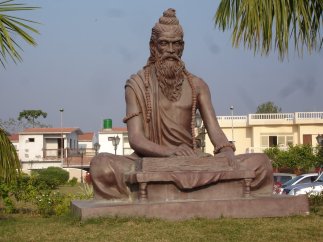Yoga is the State of No-Mind
By Rudra Shivananda
 To understand yoga as expounded by Patanjali, we must also study the Sanskrit term “nirodha” which occurs in the same sutra 2 as the terms citta and vritti.
To understand yoga as expounded by Patanjali, we must also study the Sanskrit term “nirodha” which occurs in the same sutra 2 as the terms citta and vritti.
Now, this nirodha has often been translated variously as restriction, suppression, inhibition and control in the context of sutra 2. These words do not seem to convey the fullness of nirodha to my satisfaction, as they all have certain shades of temporariness and imply that a constant vigilance and/or effort is required to maintain the state of yoga.
It is certainly true that one will need to make the effort and control the fluctuations of the mind, most notably the thoughts that come and go, in the process of yoga. It is instructive to consider that just as the word yoga is both a process and a state, and while we practice yoga using the techniques of our chosen path, the state of yoga is beyond techniques and practice. The word nirodha is also both process and a state and during the process, control of the vrittis is necessary while the attainment of the state of nirodha would imply the cessation of the effort of control.
It is helpful to look at how the word nirodha is also used by the Lord Buddha before the time of Patanjali – he used it in the sense of extinction as in “dukkha nirodha,” the extinction of suffering, one of the noble truths he expounded upon his enlightenment.
It would seem that cessation or extinction is a better fit for sutra 2: “Yoga is the cessation of the fluctuations of consciousness,” as it removes the need for constant effort in the attainment of the state of yoga. Although there are significant differences in the usage of
certain Sanskrit terms between Maharishi Patanjali and Lord Buddha and it would be erroneous to use the Buddhist meanings in most cases, I think that this is one occasion where it may be more to the point.
According to Patanjali, there are various levels or layers of consciousness or chitta and consequently there are corresponding levels of nirodha. At the level of the state of dhyana consciousness, the process of control is over the vrittis directly and one can attain to dhyananirodha or a no-thought state which leads to the next chitta level of samprajnata samadhi or ecstasy of duality. At this level, no gross thoughts arise but there are abstract forms of thoughts or “presented ideas” called pratyaya and nirodha has to be applied to them.
When pratyaya nirodha is accomplished, one attains to the chitta level of asamprajnati samadhi or non-dual ecstasy at which state, no forms arise but the karmic samskaras or stored impressions appear into our awareness so that we can apply the process of nirodha.
When in the course of time, samskara- nirodha is attained, one is then ready to pierce the cloud of unknowing and experience dharma-megha samadhi in which one can extinguish even the three mighty principles of existence (gunas) – tamas, rajas and sattva and resolve them into their constituents.
At this level, one accomplishes sarvanirodha or complete cessation, a state with no chitta, no-mind or consciousness, but a state of complete awareness